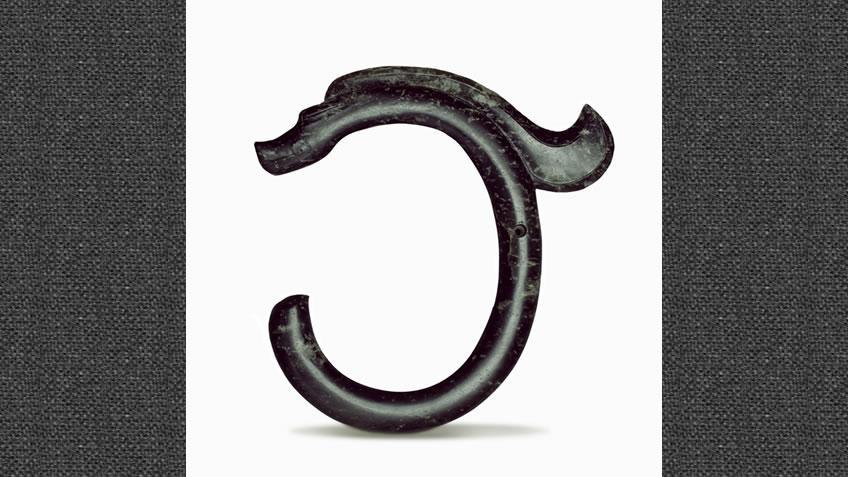Chinese Relics
Jade Dragon of the Hongshan Culture

| What is it?
Name: Jade Dragon of the Hongshan Culture
Historical Period: 5,000-6,000 years ago (The Stage of the Hongshan Culture)
Height: 26 cm
Excavation Site: Ongniud Banner, Chifeng City, Inner Mongolia
Housed in: National Museum of China
| What's the story?
Hailed as "China's first dragon" by archaeologists, the Jade Dragon of the Hongshan Culture empirically authenticated the origin of dragon, physically verified the identity of the Chinese nation as "descendants of the dragon," and significantly advanced the studies of the development sequence of Chinese dragon culture.
Presence of the Jade Dragon
In 1984, Jia Hong'en, a curator of the Cultural Center in Ongniud Banner, Inner Mongolia, believed that the jade ware he bought for 30 yuan was more than important. He took the jade to Beijing by train and sought the help of Su Bingqi, then president of the Chinese Archaeological Society. After careful examination, Su and other specialists from the Palace Museum agreed that Jia's jade ware was a dark-colored jade dragon of the Hongshan Culture, dating back more than 5,000 years ago and the earliest dragon-shaped jade ware unearthed in China.
The dark-colored jade dragon is elaborately carved out of the finest materials. With a lifelike appearance, its shape resembles the Chinese character "龙" (dragon in English, Long in Chinese pinyin) in oracle bone inscriptions. The hole on the dragon's back is ingeniously designed. Hung by a rope, the dragon head and tail are balanced and positioned in a horizontal line. In a way, the jade dragon is known as "China's first dragon."
As a typical case among the cultural relics of dragon in China, the Jade Dragon of the Hongshan Culture helped solve some of the myths of dragon in archaeology.
Dragon worship of the Chinese nation
With continuous developments in archaeology in China, more archaeological materials about the origin of dragon culture has been discovered, revealing more about the identity consciousness of the Chinese nation as "descendants of the dragon."
In 1987, a relic with a dragon-tiger pattern was unearthed at a Yangshao Culture site in Xishuipo, Puyang, Henan Province, dating back to around 6,400 years ago. It is meticulously shaped with mussel shells. The tiger pattern stands on the left, and the dragon pattern on the right. Looking east, the dragon raises its head and arches its back, with four feet and a long tail wagging as if it were soaring freely in the sky.
There are many other dragon relics, including the dragon-shaped jade ware with diaglyph unearthed at Lingjiatan, Anhui Province, dating back to 5,300-5,500 years ago; and a painted dragon-pattern pottery plate unearthed at Taosi Site, Shanxi Province, dating back to 3,900-4,300 years ago.
Apparently, dragon played an important role in the spiritual life of the Chinese ancestors as early as in ancient times.
The images of the dragon kept evolving. In the Xia (c.2070-1600 BC), Shang (1600-1046 BC) and Western Zhou dynasties (1046-771 BC), the image of the dragon existed in various forms. It was not until the Warring States Period (475-221 BC) and the Qin (221-206 BC) and Han dynasties (206 BC- AD 220) that the image of the dragon gradually became unified.
Wang Fu, a thinker in the Eastern Han Dynasty (25-220), famously summarized its appearance as such: "Its horns are like those of a deer; its head is like that of a camel; its eyes are like those of a rabbit; its neck is like that of a snake; its belly is like that of a giant clam; its scales are like those of a fish; its claws are like those of an eagle; its feet are like those of a tiger, and its ears are like those of a bull." So far, the general appearance of the Chinese dragon has been largely established.
In the long and continuous period of its development, Chinese dragon culture was significantly aligned with the origin and development of the Chinese nation and the Chinese civilization. From diverse forms to a unified appearance, the image of dragon eventually became a symbol of the great unification of China and the Chinese nation.
Source: Becoming the Chinese Nation: The historical memories of multi-ethnic Chinese Nation in 100 cultural relics
Liu Xian /Editor Chi Jianfeng /Translator
Yang Xinhua /Chief Editor Ren Qiang /Coordinator
Liu Li /Reviewer
Zhang Weiwei /Copyeditor Tan Yujie /Image Editor
The views don't necessarily reflect those of DeepChina.
